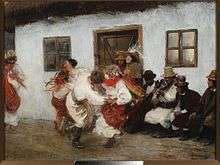Kolomyjka
The kolomyjka (Ukrainian: кoлoмийкa, Polish: kołomyjka; also referred to as kolomeyka or kolomeike) is a Hutsul(Ukrainian) music genre[1][2][3]that combines a fast paced folk dance and comedic rhymed verses. It also refers to a type of performance dance developed by the Ukrainian diaspora in North America.

It originated in the eastern Galician (Modern West Ukrainian) town of Kolomyia (Hutsulshchyna). It was historically popular among the Ukrainians and Poles, and is also known in north-eastern Slovenia where in Austro-Hungarian times some Ukrainians settled (as the kalamajka) .[4]
Kolomyjkas are still danced in Ukraine, as a tradition on certain holidays, during festivities, or simply for fun. In Ukraine's west, they are popular dances for weddings.
The Kolomyka can be a combination of tune, song, and dance with some recordings having a line of singing alternating with a line of instrumental melody, whilst others are purely instrumental. The text tends to be in rhyming couplets and is a humorous commentary on everyday life. Its simple 2/4 rhythm and structures make the kolomyka very adaptable, and the text and melodies of thousands of different versions have been annotated. One collection done by Volodymyr Shukhevych in 1905, contains more than 8,000. Although a very old form they continue to be popular due to their fast, energetic and exciting melodies often with syncopation.[5]
Bela Bartok and the Kolomyjka
Hungarian composer Bela Bartok's first concerto for piano and orchestra incorporates a rhythmic and melodic scheme that has a symmetrical structure, combinig two measure units, that move typically in a narrow stepwise motion and often use scalar patterns and note repetitions. In Hungary, this rhythmic type is associated with the swineherd dance that Bartok believed was derived from the Ukrainian kolomyka. Bartok also considered the swineherd songs to be the source of the popular kurucz song repertoire and of the instrumental verbunktos, suggesting that these too were based on Kolomyka melodies[6]-"The latter (Verunkos), again, seems at least partially a derivation from the so-called Hungarian Sheperd-dance melodies whose source is probably the Ukrainian Kolomyjka dance-melodies" (Bela Bartok), "Concerning the origin of the Rumanian (b) 1 and (c) types, let us indicate two alternatives, however, in principle equally possible. They may have originated directly from either the Verbunkos music or the Ukrainian Kolomyjka. The latter alternative is likely because of the comparatively long frontier between Rumanian and Ukrainian linguistic territory." (Bela Bartok)[7]
Development in the diaspora
In North America, the kolomyjka is primarily a social dance. Participants form a circle, joining hands. The dance begins with the participants turning the circle, usually counterclockwise, then clockwise, or by forming a spiral. Further into the dance soloists will perform in the centre of the circle.
According to Andriy Nahachewsky, a former professional stage dancer, Director of the Kule Centre for Ukrainian and Canadian Folklore, and Huculak Chair of Ukrainian Culture and Ethnography at the University of Alberta, kolomyjky as practised in Canada are a separate genre of dance from what is known in Ukraine. The diasporic kolomyjka developed from the old country folk dance but with a prevailing influence from stage dancing. Originating in Western Canada in the 1950s and 60s, the kolomyjka is considered the highlight of Ukrainian weddings and dances in Canada: when any attendees who have experience as stage dancers perform their favourite "tricks" involving lifts, spins, high kicks, even building human pyramids. It is a chance for individuals and groups to "show off" their most impressive or dangerous moves so as to entertain the audience and win approval. Nahachewsky suggests that despite being a relatively new tradition the Canadian kolomyjka is an important symbol of Ukrainian culture in Canada and that the dynamism of this type of Ukrainian dance helps to interest young people in Canada in retaining Ukrainian culture.[8]
Performers
- Ruslana, Kolomyjka-motives through pop-genre
References
- "The Cambridge Companion to Chopin".
a theme by Kurpinski, probably based on an original Ukrainian Kolomyjka (a duple-time round dance)
- "The Ashley Dancers".
"Kolomyjka (Ukrainian)" Roland Verfaillie
- "Folk Dances for Boys and Girls". 1929. p. 59.
Kolomyka-Ukraine
- Baš, Angelos. 1980. Slovensko ljudsko izročilo: pregled etnologije Slovencev. Ljubljana: Cankarjeva založba, p. 228.
- "The Fiddle Handbook".
- Frigyesi, Judit. "Béla Bartók and Turn-of-the-Century Budapest".
- Bartok, Bela. "Rumanian Folk Music: Instrumental Melodies".
- Mithrush, Fawnda (Spring 2014). "From dancer to academic" (PDF). ACUA Vitae. 19 (1). Edmonton: Alberta Council for the Ukrainian Arts. pp. 16–17. Archived from the original (PDF) on 2014-07-27. Retrieved 2014-07-26.
External links